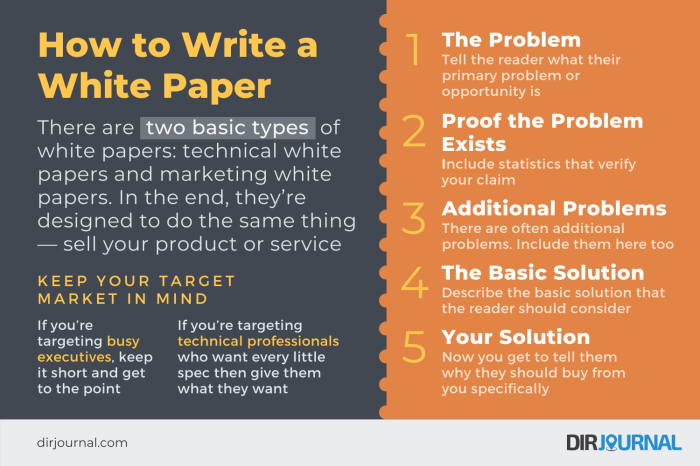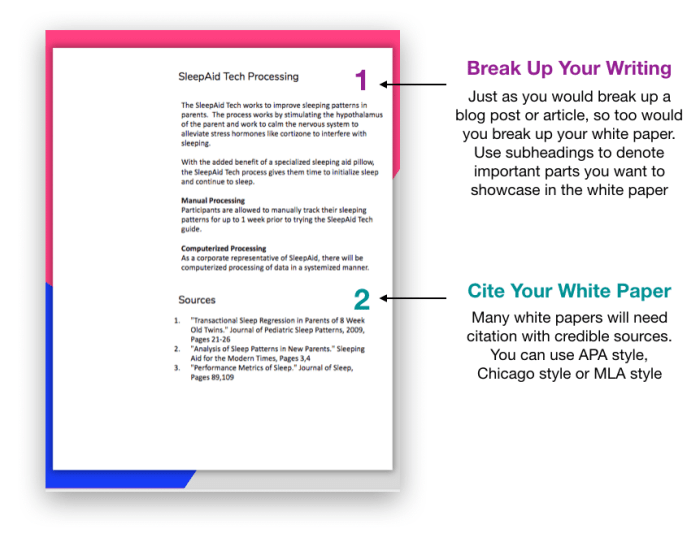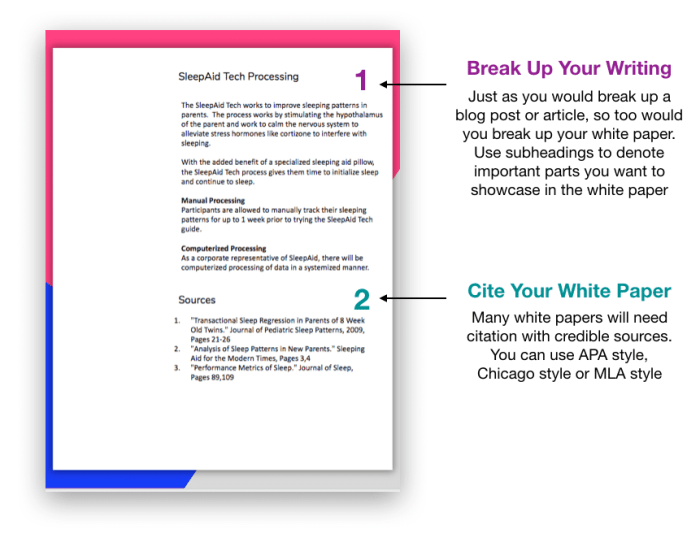Writing Whitepapers kicks off with a bang, diving into the world of creating impactful business documents that establish authority and drive engagement. Get ready to explore the key elements, research strategies, writing styles, and more in this dynamic guide.
Introduction to Writing Whitepapers
A whitepaper is a persuasive, authoritative, and in-depth report that presents a problem and provides a solution. In the business world, whitepapers are used to educate readers about complex issues, showcase a company’s expertise, and ultimately influence decision-making.
Importance of Whitepapers in Establishing Thought Leadership
Whitepapers play a crucial role in establishing thought leadership within an industry. By offering valuable insights, analysis, and solutions to pressing problems, companies can position themselves as experts and gain credibility among their peers and target audience.
Industries Where Whitepapers are Commonly Used
- Technology: Companies in the tech industry often use whitepapers to explain new technologies, trends, and best practices.
- Finance: Financial institutions use whitepapers to discuss investment strategies, market analysis, and regulatory changes.
- Healthcare: Whitepapers in the healthcare industry focus on medical research, treatment options, and healthcare policies.
Target Audience for Whitepapers
Whitepapers are typically targeted towards professionals, decision-makers, and experts within a specific industry. They are designed to appeal to individuals seeking in-depth knowledge, insights, and solutions to complex problems relevant to their field of expertise.
Key Elements of a Whitepaper
When creating a whitepaper, it is crucial to include key elements that will effectively convey your message and persuade your audience. These elements help structure the document in a way that engages readers and presents information logically and convincingly.
Executive Summary
The executive summary is a brief overview of the whitepaper, highlighting the main points and key findings. It should provide a snapshot of the content to give readers a quick understanding of what to expect.
Introduction
The introduction sets the stage for the whitepaper by introducing the topic and providing background information. It should grab the reader’s attention and establish the purpose of the document.
Problem Statement
Identifying the problem is crucial in a whitepaper. Clearly defining the issue at hand helps to focus the discussion and provides a basis for proposing solutions.
Solutions
In this section, you present your proposed solutions to the problem Artikeld in the previous section. It is essential to provide detailed explanations and reasoning behind each solution.
Data, Statistics, and Case Studies
Supporting your claims with data, statistics, and case studies adds credibility to your whitepaper. It helps to validate your arguments and provide evidence for the effectiveness of your proposed solutions.
Conclusion
The conclusion summarizes the key points of the whitepaper and reinforces the main takeaways. It should leave a lasting impression on the reader and emphasize the importance of the information presented.
Visuals: Charts and Graphs, Writing Whitepapers
Incorporating visuals like charts and graphs can enhance the readability of a whitepaper by providing visual representations of complex data. Visual aids help readers grasp information more easily and can make the content more engaging.
Research and Data Collection for Whitepapers

Research and data collection are crucial steps in creating a well-informed and comprehensive whitepaper. Here’s how you can go about gathering and validating data for your whitepaper.
Conducting Thorough Research
When conducting research for a whitepaper, it is essential to utilize a variety of sources. This can include academic journals, reputable websites, industry reports, and interviews with experts in the field. By gathering information from diverse sources, you can ensure that your whitepaper is well-rounded and provides a holistic view of the topic.
- Utilize online databases and libraries to access scholarly articles and research papers.
- Interview subject matter experts to gather insights and real-world examples.
- Review case studies and whitepapers from reputable organizations to strengthen your argument.
Validating Sources and Credibility
It is crucial to validate the credibility of your sources to ensure the accuracy and reliability of the information presented in your whitepaper. Here are some tips to help you validate your sources:
- Check the author’s credentials and expertise in the field.
- Verify the publication date to ensure the information is up-to-date.
- Cross-reference information from multiple sources to confirm its accuracy.
Process of Analyzing Data
Once you have gathered data for your whitepaper, it’s time to analyze and synthesize the information into compelling content. Here’s how you can transform raw data into a well-structured whitepaper:
- Organize data into key themes or categories to identify trends and patterns.
- Use data visualization tools to present complex information in a clear and concise manner.
- Draw connections between different data points to provide a comprehensive analysis of the topic.
Citing Sources Properly
Properly citing your sources is essential to maintain the credibility and integrity of your whitepaper. Here are some tips on citing sources and references correctly:
- Use a consistent citation style, such as APA or MLA, throughout your whitepaper.
- Include in-text citations for direct quotes, paraphrased information, and statistical data.
- Provide a detailed reference list at the end of your whitepaper to acknowledge all sources used.
Writing Style and Tone for Whitepapers: Writing Whitepapers

When it comes to writing whitepapers, it’s crucial to maintain a formal, informative, and persuasive style throughout the document. This helps establish credibility and allows the reader to trust the information being presented.
Maintaining a Professional Tone
It’s essential to use a professional tone in whitepapers to convey authority and expertise. Avoid slang, jargon, or overly casual language that may detract from the seriousness of the content.
Simplifying Complex Concepts
Breaking down complex ideas into simpler terms is key to ensuring the reader’s understanding. Use clear explanations, examples, and analogies to simplify intricate concepts without compromising accuracy.
Engaging the Reader
To keep the reader interested, consider using compelling storytelling, relevant statistics, and real-life examples. Additionally, incorporating visuals and interactive elements can enhance engagement and make the whitepaper more appealing.
